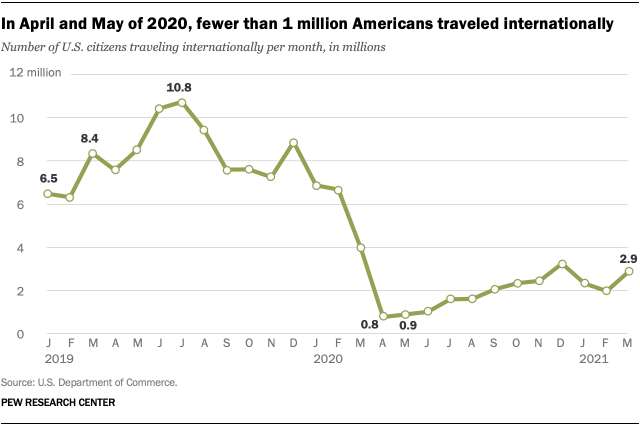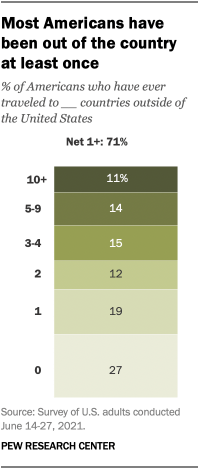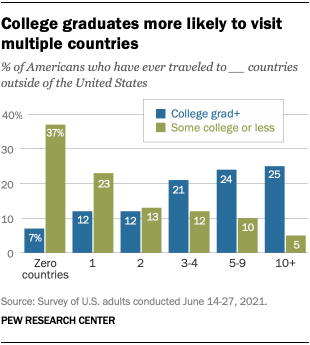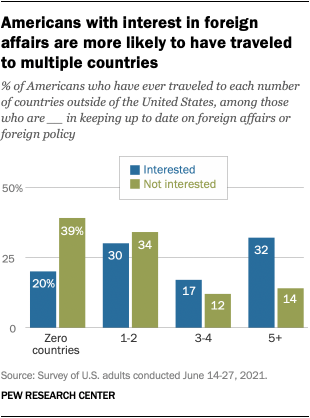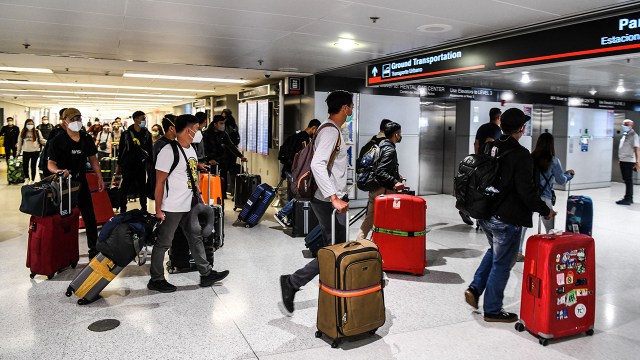
Americans are gradually returning to international travel, though international travel restrictions remain in place in many countries.
In March 2021 – the most recent month for which data is available – around 3 million American citizens traveled outside of the country. This is shy of the nearly 4 million U.S. citizens who traveled abroad in March 2020 as the coronavirus pandemic unfolded and far below the roughly 8 million who did so in March 2019, according to U.S. Department of Commerce data. But it represents a significant uptick over the low point in the late spring of 2020, when only around 1 million Americans or fewer left the United States. Still, international travel by Americans remains far below pre-pandemic levels.
To provide context for the impact of the COVID-19 pandemic on international travel, this post looks at the habits of Americans when it comes to who most frequently goes abroad, as well as those groups in the U.S. who have been less likely to do so. To do this, we analyzed I-92 data from the International Air Travel Statistics Program at the U.S. Department of Commerce. This data includes all flights in and out of the U.S. and reports the total volume of air traffic as well as the number of U.S. citizens traveling.
The post also uses findings from a Pew Research Center survey conducted June 14-27, 2021. The survey sampled 10,606 adults who are part of the Center’s American Trends Panel (ATP), an online survey panel that is recruited through national, random sampling of residential addresses. This way nearly all U.S. adults have a chance of selection. The survey is weighted to be representative of the U.S. adult population by gender, race, ethnicity, partisan affiliation, education and other categories. Read more about the ATP’s methodology.
Here are the questions used for the report, along with responses, and its methodology.
Whether before or during the pandemic, international travel is something a 71% majority of U.S. adults have done at some point in their lives, according to a June Pew Research Center survey. By contrast, around a quarter (27%) have not traveled abroad.
Still, the degree to which Americans have traveled around the globe varies widely: 19% have been to only one foreign country, 12% to two countries, 15% to three or four countries, and 14% to five to nine countries. Only 11% of Americans have been to 10 or more countries.
Who travels – and how much – also differs substantially across demographic groups. Income plays a decided role: Almost half (48%) of those earning less than $30,000 a year have not left the country, compared with 28% of those who earn between $30,000 and $79,999 a year and 10% of those earning $80,000 or more. These highest earners are also significantly more likely to have visited multiple countries.
Americans with lower levels of education are much less likely to have traveled widely than those with more schooling. For example, 37% of those with just some college education or less have not left the country, compared with only 7% of those who have graduated college. College graduates are also more likely to have been to multiple countries: A quarter have been to 10 or more countries.
Women (32%) are more likely than men (22%) to have never traveled outside the country. Men, for their part, are much more likely than women to have been to five or more countries (30% vs. 22%). Still, men and women are equally likely to have been to only one country.
Black Americans are much less likely to have ever traveled abroad (49%) than White (75%) or Hispanic Americans (73%). White adults are also more likely to have been to five or more countries (30%) than Black (13%) or Hispanic (15%) adults.
When it comes to party affiliation, there are no significant differences in the share of Republicans and Democrats who have traveled internationally or in the number of countries they have visited.
The 64% of Americans who say they are at least somewhat interested in keeping up to date on foreign affairs or foreign policy are much more likely to have traveled abroad at some point in their lives than those who say they have limited or no interest. They are also more likely to have been to many countries. For example, 32% of those who are interested in foreign affairs or foreign policy have been to at least five foreign countries, compared with 14% who are less focused on keeping up to date on foreign affairs.
Note: Here are the questions used for the report, along with responses, and its methodology.



